Back to Journals » Journal of Pain Research » Volume 15
Knowledge Mapping of International Research on Acupuncture for Chronic Pain: A Bibliometric Analysis
Authors Jiao H , Ding R, Jin P, Wang J, Xu J, Tian W
Received 14 October 2022
Accepted for publication 29 November 2022
Published 2 December 2022 Volume 2022:15 Pages 3711—3728
DOI https://doi.org/10.2147/JPR.S392796
Checked for plagiarism Yes
Review by Single anonymous peer review
Peer reviewer comments 2
Editor who approved publication: Dr Houman Danesh
Video abstract presented by Hongguan Jiao.
Views: 109
Hongguan Jiao,1 Ran Ding,2 Pukai Jin,3 Junwen Wang,4 Jun Xu,5 Weiyi Tian6
1School of Information Engineering, Guizhou University of Traditional Chinese Medicine, Guiyang, People’s Republic of China; 2School of Health Preservation of Traditional Chinese Medicine, Guizhou University of Traditional Chinese Medicine, Guiyang, People’s Republic of China; 3Department of Radiology, Inova Mount Vernon Hospital, Alexandria, VA, USA; 4Institute of Basic Theory of Traditional Chinese Medicine, China Academy of Chinese Medical Sciences, Beijing, People’s Republic of China; 5Information Institute of Traditional Chinese Medicine, China Academy of Chinese Medical Sciences, Beijing, People’s Republic of China; 6School of Basic Medicine, Guizhou University of Traditional Chinese Medicine, Guiyang, People’s Republic of China
Correspondence: Hongguan Jiao, School of Information Engineering, Guizhou University of Traditional Chinese Medicine, Guiyang, People’s Republic of China, Tel +86-18886094606, Fax +86-851-88233048, Email [email protected]
Introduction: With the wide acceptance of acupuncture, many papers and guidelines recommend that acupuncture is effective for chronic pain (CP). In this study, we applied bibliometric methods to analyze the current research situation of acupuncture intervention in CP, to gain insight into the current situation and future development trend of this field.
Material and Methods: Science Citation Index Expanded was searched for publications related to acupuncture for CP between 1900 and 2022. VOSviewer, CiteSpace and Thomson Data Analyzer were used to analyze the annual publication, authors and cited authors and their countries (regions) and institutions, journals and cited journals, cited references, co-occurrence keywords, burst keywords, and the relevant centrality.
Results: A total of 1968 papers were retrieved, the annual publications have shown a rapid growth trend in the recent 20 years. The USA (708) and the Kyung Hee University (31) were the most productive country and institution, respectively, while the USA (0.37) and University of Maryland (0.13) had the highest centrality. MacPherson, Hugh published the most papers in this field (29), and Vickers, A J were the most influential author (289 times cited). Journal of Alternative and Complementary Medicine was the most productive journal (92), whereas PAIN was the most influential one (4743 times cited). Breivik, H’s (2006) paper had the most citation count (3025), while Furlan’s (2005) paper had the highest centrality (0.23). The research focuses in this field mainly include pain, electroacupuncture, Low back pain, Systematic review, Randomized controlled trial etc. Researchers are currently paying more attention to the psychological problems caused by CP.
Conclusion: The research of acupuncture for CP will be further expanded. International cooperation of this research field needs to be further strengthened. More high-quality designed trials need to be conducted.
Keywords: chronic pain, acupuncture, bibliometric analysis, VOSviewer, CiteSpace
Introduction
Chronic pain (CP) usually refers to pain that affects daily functioning for more than three months, which is often accompanied by stress. More than 50% of the elderly population suffers from CP, and 80% of the elderly living in nursing homes has CP.1 In general, CP can be isolated and requires medical intervention. CP includes various conditions such as fibromyalgia or nonspecific low-back pain, chronic cancer-related pain, chronic neuropathic pain, chronic secondary visceral pain, chronic posttraumatic and postsurgical pain, chronic secondary headache and orofacial pain, and chronic secondary musculoskeletal pain etc.2,3 Chronic primary musculoskeletal pain is a condition in its own right. Chronic secondary musculoskeletal pain is a symptom that arises from an underlying disease classified elsewhere.4
Acupuncture originated from China and has been used in the Far East for more than 2000 years. Since the early 1970s, this therapy has been gaining popularity among Western world.5 Acupuncture as an important part of complementary and alternative therapies is one of the non-pharmacological therapies has been utilized to treat a wide range of diseases. Acupuncture played an important role in pain management as well.6–11 Acupuncture is considered to be effective in the treatment of chronic and acute pain.12–17 Animal and clinical trials related to the mechanism of acupuncture in treating pain have verified the effectiveness of acupuncture for pain.18–22 More and more insurance companies in different countries or regions have incorporated acupuncture into medical insurance to treat pain and various diseases.23–31 This also proves that acupuncture is widely accepted worldwide.32,33
The research on acupuncture treatment of pain and CP is gradually increasing, which sometimes brings difficulty to researchers in reading relevant literature. Bibliometrics is to analyze the literature data through mathematical and statistical methods and get the useful information hidden in the massive data.34 It is used in several fields to evaluate the countries, institutions, journals, authors, journals and keywords involved in relevant research.35–37 Some scholars applied bibliometrics to study the development of acupuncture in various fields and predict its future development.38–43 As far as we know, currently there is no bibliometric study conducted on acupuncture for CP. In order to understand the development of acupuncture for CP, in this study we used CiteSpace, Thomson Data Analyzer (TDA), Microsoft Excel and VOSviewer to conduct this research of the CP papers.
Materials and Methods
Data Collection
The data of this research was collected from Science Citation Index Expanded (SCI-EXPANDED) of the Web of Science (WoS). The search queries were: TS=(chronic pain) AND TS=(acupuncture), Indexes=SCI-EXPANDED, Time span=1900-01-01 to 2022–04-30. No language and document type limited. Retrieval date: May 05, 2022. A total of 1968 papers were included.
Analysis
The analysis of this paper included the following: (1) descriptive statistical analysis, descriptive analysis of the annual publication volume, countries, institutions, authors, journals, cited authors and cited journals; (2) citation analysis, co-cited maps for journals; (3) co-occurrence analysis, co- occurrence map for keywords; (4) burst keywords.
Analysis Tools
CiteSpace V
CiteSpace (6.1.3) is a bibliometric visualization analysis software that is gradually developed under the background of metrology and data visualization, focusing on the potential knowledge contained in the research society. Since the structure, rules and distribution of scientific knowledge are presented through visual means, the visualized graphs obtain through such methods are also called “scientific knowledge graphs”.44 Betweenness centrality is an important indicator for measuring nodes in the network. CiteSpace uses this indicator to discover and measure the importance of items such as papers, authors, references etc. Burst is used to detect fast-growing or fast-changing events such as topics, papers, authors, and journal citation etc.45,46
TDA
Thomson Data Analyzer (TDA 6.5) is a Thomson Reuters product that is powered by VantagePoint. TDA has special import filters and reporting macros specifically designed for analyzing scientific literature from Web of Science.
VOSviewer
VOSviewer is a software for constructing and visualizing bibliometric networks. These networks may for instance include journals, researchers, or individual publications, and they can be constructed based on citation, bibliographic coupling, co-citation, or co-authorship relations. VOSviewer also offers text mining functionality that can be used to construct and visualize co-occurrence networks of important terms extracted from a body of scientific literature.47,48 The VOSviewer (version 1.6.17) was used to explore the network patterns, and identify and visualize countries or regions, institutions, authors and cited authors, journals and cited journals, references, and co-occurrence keywords. The different nodes represent different items while the size of the nodes determined by the weight of the item, reflects the productivity. Lines between items represent links. Thicker lines mean stronger links.
Results
Analysis of Annual Publication
In the total of 1968 papers, the number of publications each year was presented in Figure 1. From 1975 to 1996, there were fluctuations of ten or less paper published each year. Started from 1997 (17 papers), the number of relevant research papers reached up to two digits, and then increased year by year. By 2015, the number had exceeded 100 and reached 125. During this period, there were some minor decreases, but overall, it was a rapid growth trend, reaching a peak of 167 papers in the year of 2020.
 |
Figure 1 The annual number of publications on acupuncture for CP indexed by SCI-E. Abbreviations: CP, chronic pain; SCI-E, Science Citation Index-Expanded. |
Analysis of Countries or Regions
A total of 59 countries or regions participated in the publication of the 1968 papers. Figure 2 shows the world distribution of the number of papers published by countries or regions. Figure 3 shows USA, people R China, Germany, England, South Korea, ranked the top 5, with more than 100 papers published respectively. Other top 20 countries or regions are Australia, Canada, Taiwan, Brazil, Italy, Switzerland, Sweden, Japan, Netherlands, Spain, Australia, Norway, Turkey, Denmark, and Scotland. Their numbers of publication are greater than or equal to 14. USA (708) and China (418) rank first and second respectively. It can be seen from Figure 4 that the United States has conducted research in this field earlier. Since 1996, the number of papers has been growing steadily until 2019. A small number of research papers were published in China from 1999 to 2011, and there was a rapid growth from 2012 to 2021. China may surpass the United States in the next few years in terms of volume publication. The top ranked item by centrality was USA, with centrality of 0.40. The second one was England, with centrality of 0.29. The third is Germany, with centrality of 0.20; China, with centrality of 0.08; South Korea, with centrality of 0.01. This shows that USA, Germany and England play an important role in the international cooperation community in this field, while China and South Korea have relatively insufficient cooperation.
 |
Figure 2 The world distribution of the number of papers on acupuncture for CP published by countries or regions. |
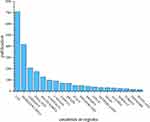 |
Figure 3 The annual publications of the top 20 countries or regions on acupuncture for CP. Abbreviations: CP, chronic pain; SCI-E, Science Citation Index-Expanded. |
 |
Figure 4 The annual publications of countries or regions on acupuncture for CP. Abbreviation: CP, chronic pain. |
VOSviewer is used for co-occurrence cluster analysis of countries or regions in this study. Eight clusters are obtained (Figure 5). The clusters showed the cooperative relationship between countries or regions. The largest cluster is the red one, most of them are from Europe, including Belgium, Denmark, England, Greece, Israel, Italy, Norway, Russia, Spain, and Sweden. The second largest cluster is green, including Iran, people R China, Singapore, Thailand, USA. The third cluster is dark blue, including Australia, Brazil, Canada and Netherlands. The fourth cluster is yellow, including Germany, South Korea, Switzerland, and Turkey. The other four clusters are purple cluster, including France, India and Malaysia; Light blue cluster, including New Zealand, North Ireland and Scotland; Orange cluster, including Austria, Japan, Taiwan; And brown cluster, including Egypt and Saudi Arabia.
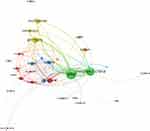 |
Figure 5 Map of countries or regions’ collaborations on acupuncture for CP. Abbreviation: CP, chronic pain. |
Analysis of Institutions
A total of 909 institutions published the 1968 papers. And 29 institutions published more than 20 papers were chosen for visualization (Figure 6). The figure displays the change of institutions in terms of time. Harvard University, Univ Calif Los Angeles, Tech Univ Munich, Univ Washington and the University of Maryland initiated the relevant study in early time. Research institutions represented by Beijing University of Chinese Medicine, Kyung Hee University, China Acad Chinese Med Sci, Chengdu Univ Tradit Chinese Med and Harvard Medical School started acupuncture for CP research in recent years. The top 15 first author’s institutions are listed in Table 1, of which Kyung Hee University had the most research papers on acupuncture for CP (31). The other four institutions of the top five are China Acad Chinese Med Sci, Chengdu Univ Tradit Chinese Med, Univ York, Beijing Univ Chinese Med. The top ranked institution by centrality was Harvard Univ, with centrality of 0.34. Tech Univ Munich was 0.26. China Acad Chinese Med Sci was 0.20.
 |
Table 1 Top 15 First Author’s Institutions Performed Research on Acupuncture for CP |
 |
Figure 6 Map of institutions’ collaborations on acupuncture for CP. Abbreviation: CP, chronic pain. |
Analysis of Authors
A total of 7820 authors participated in the publication of the papers. Top 15 authors are listed in Table 2. The top 5 authors are MacPherson, Hugh from Univ York, England; Linde, Klaus from Tech Univ Munich, Germany; Witt, Claudia M from Charite Med Ctr, Germany; Sherman, Karen J from Ctr Hlth Studies, USA; Kaptchuk, Ted J from Harvard Univ, USA. Co-occurrence analysis can reveal the cooperative relationship between authors. Figure 7 presents the cooperative relationship of the authors have published five or more papers. The thickness of connections between nodes or groups shows the strength of their cooperation. The figure shows that there are ten mature cooperation teams. The top ranked authors by centrality was LEE J, with centrality of 0.41, the second one was LIU J, with centrality of 0.39, which indicates that these two authors are important authors of their cooperation with other authors.
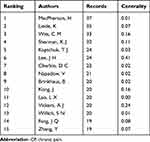 |
Table 2 Top 15 Authors Who Performed Research on Acupuncture for CP |
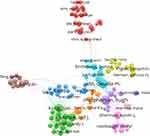 |
Figure 7 Map of authors’ collaborations on acupuncture for CP. Abbreviation: CP, chronic pain. |
Analysis of Cited Authors
Table 3 presents Top 10 cited authors performed research on acupuncture for CP. The first 5 authors are: Vickers, A J from Mem Sloan Kettering Canc Ctr, USA; MacPherson, Hugh from Univ York, England; Ernst, E from Univ Exeter, England; Han, J S from Peking Univ, Peoples R China; Linde, Klaus from Tech Univ Munich, Germany. These scholars have high influence in this research field.
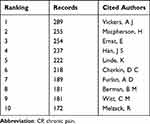 |
Table 3 Top 10 Cited Authors Performed Research on Acupuncture for CP |
Analysis of Journals
A total of 547 journals published the 1968 papers. The top 10 journals account for 28% of the whole production (Table 4). The categories of journals mainly include complementary and alternative medicine, acupuncture, pain, and general medicine. The top five journals are: JOURNAL OF ALTERNATIVE AND COMPLEMENTARY MEDICINE (92), EVIDENCE BASED COMPLEMENTARY AND ALTERNATIVE MEDICINE (88), ACUPUNCTURE IN MEDICINE (74), MEDICINE (61), TRIALS (50). According to the Journal Citation Reports (2021), the average Impact factor (IF) of these top 10 journals is 4.19.
 |
Table 4 Top 10 Relevant Journals on Acupuncture for CP Research |
Analysis of Cited Journals
A total of 10,828 journals were cited. Figure 8 shows 58 journals have been cited more than 200 times are included in the map. Clustering relationship between nodes is represented by color. The closer the journals are, the thicker the links are which means that they are more relevant in the field of CP research and are cited together. Table 5 presents Top 10 Cited Journals on Acupuncture for CP Research. The top 10 cited journals are: PAIN (4743), SPINE (2314), COCHRANE DB SYST REV (1499), J ALTERN COMPLEM MED (1298), ANN INTERN MED (1256), ACUPUNCT MED (1203), JAMA-J AM MED ASSOC (1157), EVID-BASED COMPL ALT (1107), BMJ-BRIT MED J (1046), CLIN J PAIN (989).
 |
Table 5 Top 10 Cited Journals on Acupuncture for CP Research |
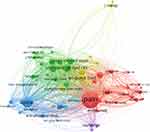 |
Figure 8 Map of co-cited journals on acupuncture for CP. Abbreviation: CP, chronic pain. |
Analysis of Keywords
A total of 2709 keywords were included in this study. For better visualization from a total of 176 keywords with frequency greater than or equal to five were included in VOSviewer for co-occurrence analysis (Figures 9 and 10). Table 6 presents the top 10 keywords. In addition to acupuncture and chronic pain, other keywords include pain, electroacupuncture, Low back pain, Systematic review, Randomized controlled trial, chronic low back pain, meta-analysis, neuropathic pain.
 |
Table 6 Top 10 Keywords Related to Acupuncture for CP Research |
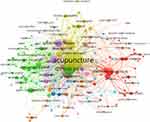 |
Figure 9 Map of co-occurrence keywords on acupuncture for CP. Abbreviation: CP, chronic pain. |
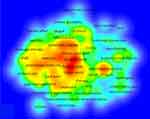 |
Figure 10 Heat map of co-occurrence keywords on acupuncture for CP. Abbreviation: CP, chronic pain. |
Analysis of Burst Keywords
“Burst keywords” refers to keywords cited frequently over some time, thereby indicating the frontier areas.44,49 Figure 11 shows 20 burst keywords sorted by the “begin year”. As can be seen from the figure, the keyword “electrical nerve stimulation” was the earliest burst keyword, with the highest strength (11.42) and lasted a very long period among these 20 burst keywords. The current burst keywords include impact, symptom, depression and stress, indicating that researchers are currently paying more attention to the psychological problems caused by CP.
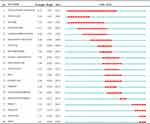 |
Figure 11 Top 20 Keywords with the Strongest Citation Bursts. |
Analysis of Citation
A total of 54,255 references were generated from the 1968 papers. Table 7 presents the top 10 cited references sorted by the citation counts. Of these ten references, one reference was survey on CP, five references were guidelines for pain including CP, one is Meta-analysis on acupuncture for CP.50 The first one introduces the situation of CP in 15 European countries and Israel, which shows that CP is widespread and the effective medical treatment is relatively insufficient.13 The second paper introduces the diagnosis and treatment of low back pain, and introduces the treatment suggestions for different types of low back pain, among which acupuncture, one of the therapies, is recommended to treat acute and chronic low back pain.51 The third and fifth are systematic reviews published by Zhang, W. OARSI recommendations for the management of hip and knee osteoarthritis, they recommended acupuncture as one of 12 non-pharmacological modalities of therapy for the pain of hip and knee osteoarthritis.14,52 The fourth reference found no consistent evidence that acupuncture provides anything more than a placebo effect in the treatment of low back pain. So, the authors cannot recommend acupuncture for the treatment of chronic low back pain.53 Zhao, Zhi-Qi studied on neural mechanisms underlying acupuncture analgesia from cellular and molecular substrate and functional brain imaging aspect.54 Kaptchuk, TJ and Han, JS found out acupuncture activates endogenous opioid mechanisms and acupuncture has regionally specific, quantifiable effects on relevant brain structures.55,56
 |
Table 7 Top 10 Cited References Related to Acupuncture for CP |
Discussion
CP is a kind of primary or secondary pain with a long duration. CP is often accompanied by depression, which seriously affects people’s quality of life. CP is more common in the elderly.1 Acupuncture as an effective non drug therapy for CP, is widely accepted and recommended by clinical guidelines (OARSI recommendations for the management of hip and knee osteoarthritis Part II, III; Noninvasive Treatments for Acute, Subacute, and Chronic Low Back Pain: A Clinical Practice Guideline From the American College of Physicians), Physicians, etc.15,36 Including acupuncture, Complementary and alternative medicine is often used for lower pain intensity pain.57
In this study, we used bibliometric methods to study papers related to acupuncture for CP between 1975 and 2022. Since the first paper was published in 1975, the number of papers published in the first 20 years has remained steady at around ten per year, showing a rapid growth trend from 1997 to 2020. At present, it still shows the momentum of continuous growth. The USA, people R China, Germany, England, South Korea, ranked the top 5, with more than 100 papers published respectively. The USA as the most prolific country has researched in this field earlier.58 From 2012 to 2021, China’s research in this field shows a rapid growth trend. The annual volume of papers published by other countries or regions remained basically stable It shows that the research on acupuncture for CP has gradually shifted from the USA centered western world to China centered East world.59 There are extensive cooperative relations between countries or regions. In terms of the importance of international cooperation, The USA is the pivot of the cooperative team. The USA, Germany and England played a major role in the international research cooperation team and have a high influence. On the contrary, China and South Korea, despite their high volume of production, have made little contribution to team cooperation. The co-occurrence cluster analysis of countries or regions shows that there are several cooperative teams, ie European team, China-USA team, Australia-Canada team, South Korea Europe team, and other small teams including Europe Asia team, East Asia team, Middle East team etc. As for research institutions, the institutions in the United States and Germany studied CP earlier than those in China and South Korea, they have more exchanges and cooperation. Kyung Hee University in South Korea has the largest number of papers. Several institutions in China have also published a large number of papers immediately after it. The institutions of the USA, Germany and China play a major role in connecting the cooperation team. As the birthplace of acupuncture, China also has more participation in the international cooperation team. From the perspective of the author analysis, the top prolific authors are from the USA and Europe. As to author cooperation network, there are several mature cooperation teams with a certain degree of cooperation between them. There are ten mature cooperation teams. However, the relationship between the cooperative teams is relatively loose, which indicates that the cooperation between prolific authors is relatively limited to smaller groups. Top five cited authors performed research on acupuncture for CP are from USA, England; China and Germany. The journals that published research papers on acupuncture for CP are mainly those in complementary alternative medicine and pain related journals. This shows that acupuncture is an important part of complementary and alternative medicine, and relevant research is not limited to complementary and alternative medicine. Moreover, there are many pain related journals, which indicates that acupuncture intervention on pain is being widely studied.60–72 But the top productive journals on acupuncture for CP’s average IF is not high (4.19). Therefore, the international influence of research on acupuncture for CP is relatively insufficient. More high-quality designed trials and papers on acupuncture for CP need to be implemented. For the cited journals, PAIN and SPINE are the core citation source journals of acupuncture for CP research. The high citation rate of SPINE indicates that CP related to spine is the focus of acupuncture for CP.69,73–87 From the perspective of research areas, electroacupuncture, low back pain, systematic review, randomized controlled trial, meta analysis are the main research focuses, which shows that researchers are very interested in verification of the effectiveness on acupuncture for CP. Trials to prove the effectiveness of acupuncture in the treatment of pain is and will be the focuses of this research field.88–92 The current burst keywords include impact, symptom, depression and stress, indicating that researchers are currently paying more attention to the psychological problems caused by CP. This shows that in recent years, researchers have gradually shifted from simply focusing on chronic pain to secondary symptoms of psychological problems caused by chronic pain, such as depression and stress.93–96 It can be seen from the highly cited papers that several clinical guidelines suggesting the application of acupuncture for CP have been cited most frequently, which also shows that demonstrating the effectiveness of acupuncture for CP is the focus of researchers in this field.14,15,51,52 However, there are also a few highly cited papers with different opinions on the efficacy of acupuncture for CP, which indicates that whether acupuncture has a therapeutic effect on pain is still controversial.53,97 This also reflects that the research on acupuncture treatment of pain will be further increased.
Some limitations should be addressed in our study. Firstly, we only used the data from the SCIE of Web of Science and most of the papers are written in English rather than other languages. Therefore, our results may not be comprehensive. In future research, if data from multiple databases are used, such as Chinese, Japanese, Korean and other languages, the research might be more comprehensive. In addition, some data are not standardized, which may lead to biased results. For example, the analysis software treats “Harvard University” and “Harvard Medical School” as two different institutions. However, as the first bibliometric analysis of acupuncture for CP research, we believe that this study can still be used to describe the overall situation and trends in this research field on a global scale.
Conclusion
CP is a common symptom that affects the entire population, especially among the elderly. The aging population has greatly increased this issue. The research papers in relevant fields in the last two decades are almost ten times that of the previous two decades. The USA and China are leading countries in this field. China may surpass the United States in the next few years in terms of volume of publication. The USA, England and Germany have high influence in international cooperation. Research institutions from the USA, Germany and China play an important role in the international cooperation team of the institution. International cooperation is relatively insufficient, which needs to be further strengthened. The overwhelming majority of the papers verified that acupuncture for CP is effective. Many highly cited literatures, such as systematic reviews and clinical guidelines, recommend acupuncture for CP. Acupuncture for CP related research might gradually shift from just pain to pain and secondary symptoms caused by pain, such as depression and stress. More rigorous trial designs and methods need to be further developed.
In summary, this bibliometric study summarizes the current situation and possible future development of acupuncture for CP, which provides a reference for further research on acupuncture for CP. The research of acupuncture for CP will be further expanded, and acupuncture will be more widely accepted by the international community.
Acknowledgments
This work was supported by the National Key Research and Development Plan of China (Grant numbers. No. 2020YFC2006000), Scientific and Technological Research Project of Traditional Chinese Medicine and Ethnic Medicine of Guizhou Administration of Traditional Chinese Medicine (Grant numbers. No. QZYY-2022-022).
Funding
This work was supported by the National Key Research and Development Plan of China (2020YFC2006000), Scientific and Technological Research Project of Traditional Chinese Medicine and Ethnic Medicine of Guizhou Administration of Traditional Chinese Medicine (QZYY-2022-022), National Natural Science Foundation of China (82074334), CACMS Innovation Fund (CI2021A00113).
Disclosure
The authors report no conflicts of interest in this work.
References
1. Bicket MC, Mao J. Chronic pain in older adults. Anesthesiol Clin. 2015;33(3):577–590. doi:10.1016/j.anclin.2015.05.011
2. Treede RD, Rief W, Barke A, et al. Chronic pain as a symptom or a disease: the IASP Classification of Chronic Pain for the International Classification of Diseases (ICD-11). Pain. 2019;160(1):19–27. doi:10.1097/j.pain.0000000000001384
3. Bennett MI, Kaasa S, Barke A, Korwisi B, Rief W, Treede RD. The IASP classification of chronic pain for ICD-11: chronic cancer-related pain. Pain. 2019;160(1):38–44. doi:10.1097/j.pain.0000000000001363
4. Perrot S, Cohen M, Barke A, Korwisi B, Rief W, Treede RD. The IASP classification of chronic pain for ICD-11: chronic secondary musculoskeletal pain. Pain. 2019;160(1):77–82. doi:10.1097/j.pain.0000000000001389
5. Acar HV. Acupuncture and related techniques during perioperative period: a literature review. Complement Ther Med. 2016;29:48–55. doi:10.1016/j.ctim.2016.09.013
6. de Medeiros MA. Perspectives in complementary medicine: mechanisms and controversies over the use of acupuncture for pain management. Pain Manag. 2019;9(5):435–439. doi:10.2217/pmt-2019-0026
7. Stein DJ. Massage acupuncture, moxibustion, and other forms of complementary and alternative medicine in inflammatory bowel disease. Gastroenterol Clin North Am. 2017;46(4):875–880. doi:10.1016/j.gtc.2017.08.015
8. Qiu J, Grine K. Complementary and alternative treatment for allergic conditions. Prim Care. 2016;43(3):519–526. doi:10.1016/j.pop.2016.04.012
9. Tsai SL, Bombacie M, Licursi M, Qian Y, Stiles GM, Lee MT. Acupuncture for pediatric sickle cell pain management: a promising non-opioid therapy. Complement Ther Med. 2020;49:102314. doi:10.1016/j.ctim.2020.102314
10. Patel M, Urits I, Kaye AD, Viswanath O. The role of acupuncture in the treatment of chronic pain. Best Pract Res Clin Anaesthesiol. 2020;34(3):603–616. doi:10.1016/j.bpa.2020.08.005
11. de Matos NMP, Pach D, Xing JJ, et al. Evaluating the effects of acupuncture using a dental pain model in healthy subjects - a randomized, cross-over trial. The Journal of Pain. 2020;21(3–4):440–454. doi:10.1016/j.jpain.2019.08.013
12. Zheng CQ, Zhou TX. Effect of acupuncture on pain, fatigue, sleep, physical function, stiffness, well-being, and safety in fibromyalgia: a systematic review and meta-analysis. J Pain Res. 2022;15:315–329. doi:10.2147/JPR.S351320
13. Breivik H, Collett B, Ventafridda V, Cohen R, Gallacher D. Survey of chronic pain in Europe: prevalence, impact on daily life, and treatment. Eur J Pain. 2006;10(4):287–333. doi:10.1016/j.ejpain.2005.06.009
14. Zhang W, Nuki G, Moskowitz RW, et al. OARSI recommendations for the management of Hip and knee osteoarthritis Part III: changes in evidence following systematic cumulative update of research published through January 2009. Osteoarthritis Cartilage. 2010;18(4):476–499. doi:10.1016/j.joca.2010.01.013
15. Qaseem A, Wilt TJ, McLean RM, Forciea MA, Amer Coll P. Noninvasive treatments for acute, subacute, and chronic low back pain: a clinical practice guideline from the American college of physicians. Ann Intern Med. 2017;166(7):514–U142. doi:10.7326/M16-2367
16. Linde K, Witt CM, Streng A, et al. The impact of patient expectations on outcomes in four randomized controlled trials of acupuncture in patients with chronic pain. Pain. 2007;128(3):264–271. doi:10.1016/j.pain.2006.12.006
17. Wu P, Zhu L, Zheng SY, et al. Transcutaneous electrical acupoint stimulation for moderate to severe pain in hepatocellular carcinoma: a protocol for a randomized controlled trial. J Pain Res. 2022;1:15.
18. Zhu XX, Xu YL, Shen Z, et al. Rostral anterior cingulate cortex-ventrolateral periaqueductal gray circuit underlies electroacupuncture to alleviate hyperalgesia but not anxiety-like behaviors in mice with spared nerve injury. Front Neurosci. 2022;15:12. doi:10.3389/fnins.2021.757628
19. Zhou KC, Wu QY, Yue JJ, et al. Electroacupuncture suppresses spinal nerve ligation-induced neuropathic pain via regulation of synaptic plasticity through upregulation of basic fibroblast growth factor expression. Acupunct Med. 2022;40(4):379–388. doi:10.1177/09645284211066499
20. Zhou D, Zhang LF, Mao LW, Cao JY, Gao JQ. Biological Mechanism on SIRT1/NLRP3/IL-18 signaling pathway of acupuncture for treatment of ischemic stroke with center poststroke pain. Comput Intell Neurosci. 2022;2022:10. doi:10.1155/2022/8958742
21. Zhao C, Xu H, Xy A, et al. Cerebral mechanism of opposing needling for managing acute pain after unilateral total knee arthroplasty: study protocol for a randomized, sham-controlled clinical trial. Trials. 2022;23(1):12. doi:10.1186/s13063-022-06066-6
22. Zhao PJ, Fu HG, Cheng H, et al. Acupuncture at ST36 alleviates the behavioral disorder of autistic rats by inhibiting TXNIP-Mediated Activation of NLRP3. J Neuropathol Exp Neurol. 2022;81(2):127–134. doi:10.1093/jnen/nlab132
23. Son C, Lim YC, Lee YS, Lim JH, Kim BK, Ha IH. Analysis of medical services for insomnia in Korea: a retrospective, cross-sectional study using the health insurance review and assessment claims data. Healthcare. 2022;10(1):17.
24. Min T, Yeo J, Lee YS, Kim SY, Lee D, Ha IH. Trends of Medical Service Utilization for Tinnitus: analysis Using 2010-2018 health insurance review and assessment service national patient sample data. Healthcare. 2022;10(8):11. doi:10.3390/healthcare10081547
25. Candon M, Nielsen A, Dusek JA. Trends in insurance coverage for acupuncture, 2010-2019. JAMA Netw Open. 2022;5(1):4. doi:10.1001/jamanetworkopen.2021.42509
26. Zahm A. Integrating acupuncture into primary care. J Altern Complement Med. 2021;27(5):384–389. doi:10.1089/acm.2020.0094
27. Dubois J, Bill AS, Pasquier J, Keberle S, Burnand B, Rodondi PY. Characteristics of complementary medicine therapists in Switzerland: a cross-sectional study. PLoS One. 2019;14(10):16. doi:10.1371/journal.pone.0224098
28. Lauche R, Cramer H, Paul A, Dobos GJ, Rampp T. Introducing integrative integrated migraine care (IIMC): a model and case presentation. Eur J Integr Med. 2012;4(1):E37–E40. doi:10.1016/j.eujim.2011.11.005
29. Park HL, Lee HS, Shin BC, et al. Traditional medicine in China, Korea, and Japan: a brief introduction and comparison. Evid Based Complement Altern Med. 2012;2012:9. doi:10.1155/2012/429103
30. Klassen E, Wiebelitz KR, Beer AM. Classical massage and acupuncture in chronic back pain - non-inferiority randomised trial. Z Orthop Unfallchir. 2019;157(3):263–269. doi:10.1055/a-0715-2332
31. Hickstein L, Kiel S, Raus C, Hess S, Walker J, Chenot JF. Acupuncture covered by statutory health insurance in Germany. An observational study based on claims data. Schmerz. 2018;32(1):30–38. doi:10.1007/s00482-017-0258-2
32. Romeyke T. Integration of complementary medicine for multilocal chronic pain: treatment results from the patient perspective. Altern Ther Health Med. 2022:AT7152.
33. Lumiere K, Zhang R, Lesnik I, Bayer S, Metcalf C, Gordon DB. Integration of Doctor of Acupuncture and Oriental Medicine (DAOM) Students in a Trauma Center’s Acute Pain Service: in-Person and Remote Training and Patient Care. Medical Acupuncture. 2022;34(2):88–95. doi:10.1089/acu.2021.0041
34. Guler AT, Waaijer CJ, Palmblad M. Scientific workflows for bibliometrics. Scientometrics. 2016;107:385–398. doi:10.1007/s11192-016-1885-6
35. Leefmann J, Levallois C, Hildt E. Neuroethics 1995-2012. A bibliometric analysis of the guiding themes of an emerging research field. Front Hum Neurosci. 2016;10:19. doi:10.3389/fnhum.2016.00336
36. Chen D, Liu Z, Luo Z, Webber M, Chen J. Bibliometric and visualized analysis of emergy research. Ecol Eng. 2016;90:285–293. doi:10.1016/j.ecoleng.2016.01.026
37. Ma RZ, Ho YS. Comparison of environmental laws publications in science citation index expanded and social science index: a bibliometric analysis. Scientometrics. 2016;109(1):227–239. doi:10.1007/s11192-016-2010-6
38. Xiong J, Wang ZW, Ruan MM, et al. Current status of neuroimaging research on the effects of acupuncture: a bibliometric and visual analyses. Complement Ther Med. 2022;71:13. doi:10.1016/j.ctim.2022.102877
39. Wei JQ, Yang ZH, Lin QT, et al. Bibliometric and visualized analysis of electroacupuncture in the past 10 years. Complement Ther Med. 2022;69:10. doi:10.1016/j.ctim.2022.102846
40. Li XP, Wei W, Wang Y, Wang Q, Liu ZB. Global trend in the research and development of acupuncture treatment on parkinson’s disease from 2000 to 2021: a bibliometric analysis. Front Neurol. 2022;13:12.
41. Huang F, Zheng BS, Wu CS, et al. International publication trends in low back pain research: a bibliometric and visualization analysis. Front Public Health. 2022;10:10.
42. Zhang F, Zhang HC. Bibliometric analysis of research trends on acupuncture for neck pain treatment over the past 20 years. J Pain Res. 2021;14:3553–3554. doi:10.2147/JPR.S346284
43. Park J, Kim H, Song MY. Bibliometric analysis of research trends on acupuncture for neck pain treatment over the past 20 years - response to Zhang and Zhang response to letter. J Pain Res. 2021;14:3803–3804. doi:10.2147/JPR.S352909
44. Chen C. CiteSpace II: detecting and visualizing emerging trends and transient patterns in scientific literature. J Am Soc Information Sci Technol. 2006;57(3):359–377. doi:10.1002/asi.20317
45. Kleinberg J. Bursty and hierarchical structure in streams. Data Min Knowl Discov. 2003;7(4):373–397. doi:10.1023/A:1024940629314
46. Chen C. Searching for intellectual turning points: progressive knowledge domain visualization. Proc Natl Acad Sci U S A. 2004;101(Suppl 1):5303–5310. doi:10.1073/pnas.0307513100
47. van Eck NJ, Waltman L. Software survey: vOSviewer, a computer program for bibliometric mapping. Scientometrics. 2010;84(2):523–538. doi:10.1007/s11192-009-0146-3
48. van Eck NJ, Waltman L. Citation-based clustering of publications using CitNetExplorer and VOSviewer. Scientometrics. 2017;111(2):1053–1070. doi:10.1007/s11192-017-2300-7
49. Chen C. A Glimpse of the First Eight Months of the COVID-19 Literature on Microsoft Academic Graph: themes, Citation Contexts, and Uncertainties. Front Res Metr Anal. 2020;5:607286. doi:10.3389/frma.2020.607286
50. Vickers AJ, Cronin AM, Maschino AC, et al. Acupuncture for chronic pain individual patient data meta-analysis. Arch Intern Med. 2012;172(19):1444–1453. doi:10.1001/archinternmed.2012.3654
51. Chou R, Qaseem A, Snow V, et al. Diagnosis and treatment of low back pain: a joint clinical practice guideline from the American college of physicians and the American pain society. Ann Intern Med. 2007;147(7):478–491. doi:10.7326/0003-4819-147-7-200710020-00006
52. Zhang W, Moskowitz RW, Nuki G, et al. OARSI recommendations for the management of Hip and knee osteoarthritis, Part II: OARSI evidence-based, expert consensus guidelines. Osteoarthritis Cartilage. 2008;16(2):137–162. doi:10.1016/j.joca.2007.12.013
53. Airaksinen O, Brox JI, Cedraschi C, et al. Chapter 4 - European guidelines for the management of chronic nonspecific low back pain. Eur Spine J. 2006;15:S192–S300. doi:10.1007/s00586-006-1072-1
54. Zhao ZQ. Neural mechanism underlying acupuncture analgesia. Prog Neurobiol. 2008;85(4):355–375. doi:10.1016/j.pneurobio.2008.05.004
55. Kaptchuk TJ. Acupuncture: theory, efficacy, and practice. Ann Intern Med. 2002;136(5):374–383. doi:10.7326/0003-4819-136-5-200203050-00010
56. Han JS. Acupuncture and endorphins. Neurosci Lett. 2004;361(1–3):258–261. doi:10.1016/j.neulet.2003.12.019
57. Hosl A, Venkat S, Stein B, et al. Use of complementary and alternative medicine in chronic pain A survey among patients in a pain clinic. Schmerz. 2021;35(6):412–418. doi:10.1007/s00482-021-00546-5
58. Li G, Zhang CX, Wang CY, Xiao L. Acupuncture against chronic postsurgical pain in non-small cell lung cancer patients A protocol of randomized controlled trial. Medicine. 2021;100(40):4.
59. Pan HT, Xi ZQ, Yu XT, Sun XQ, Wei XQ, Wang K. Knowledge mapping analysis of international research on acupuncture for low back pain using bibliometrics. J Pain Res. 2021;14:3733–3746. doi:10.2147/JPR.S340992
60. Zhou XX, Dai WB, Qin Y, et al. Electroacupuncture relieves neuropathic pain by inhibiting degradation of the ecto-nucleotidase PAP in the dorsal root ganglions of CCI mice. Eur J Pain. 2022;26(5):991–1005. doi:10.1002/ejp.1923
61. Shi P, Liu JW, Du JH, Yu HL, Fang FF. Pain modulation induced by electronic wrist-ankle acupuncture: a functional near-infrared spectroscopy study. Pain Pract. 2022;22(2):182–190. doi:10.1111/papr.13076
62. Panicker L, Prasun MA, Stockmann C, Simon J. Evaluation of chronic, noncancer pain management initiative in a multidisciplinary pain clinic. Pain Manag Nurs. 2022;23(2):122–127. doi:10.1016/j.pmn.2021.09.003
63. Ma BF, Williams JP, Zhang JF, Wang RG, Guo J, An JX. Electroacupuncture alleviates thalamic pain in rats by Suppressing ADCY1 protein upregulation. Pain Physician. 2022;25(4):E627–E640.
64. Li WR, Dai DQ, Chen AW, Gao XF, Xiong LZ. Characteristics of zusanli dorsal root ganglion neurons in rats and their receptor mechanisms in response to adenosine. J Pain. 2022;23(9):1564–1580. doi:10.1016/j.jpain.2022.04.003
65. Ishiyama S, Shibata Y, Ayuzawa S, Matsushita A, Matsumura A, Ishikawa E. The modifying of functional connectivity induced by peripheral nerve field stimulation using electroacupuncture for migraine: a Prospective Clinical Study. Pain Med. 2022;23(9):1560–1569. doi:10.1093/pm/pnac048
66. Huang CH, Tsai LH, Sun MF, Fu ZH, Sun J, Chou LW. Rapid Improvement in Neck Disability, Mobility, and Sleep Quality with Chronic Neck Pain Treated by Fu’s Subcutaneous Needling: a Randomized Control Study. Pain Res Manag. 2022;2022:14. doi:10.1155/2022/7592873
67. Cao ZM, Chen YC, Liu GY, et al. Abnormalities of Thalamic Functional Connectivity in Patients with Migraine: a Resting-State fMRI Study. Pain Ther. 2022;11(2):561–574. doi:10.1007/s40122-022-00365-1
68. Black AC, Zeliadt SB, Kerns RD, et al. Association between exposure to complementary and integrative therapies and opioid analgesic daily dose among patients on long-term opioid therapy. Clin J Pain. 2022;38(6):405–409. doi:10.1097/AJP.0000000000001039
69. Strijkers RHW, Schreijenberg M, Gerger H, Koes BW, Chiarotto A. Effectiveness of placebo interventions for patients with nonspecific low back pain: a systematic review and meta-analysis. Pain. 2021;162(12):2792–2804. doi:10.1097/j.pain.0000000000002272
70. Jang JH, Song EM, Do YH, et al. Acupuncture alleviates chronic pain and comorbid conditions in a mouse model of neuropathic pain: the involvement of DNA methylation in the prefrontal cortex. Pain. 2021;162(2):514–530. doi:10.1097/j.pain.0000000000002031
71. Sato KL, Sanada LS, da Silva MD, Okubo R, Sluka KA. Transcutaneous electrical nerve stimulation, acupuncture, and spinal cord stimulation on neuropathic, inflammatory and, non-inflammatory pain in rat models. Korean J Pain. 2020;33(2):121–130. doi:10.3344/kjp.2020.33.2.121
72. Natbony LR, Zhang NS. Acupuncture for migraine: a review of the data and clinical insights. Curr Pain Headache Rep. 2020;24(7):6. doi:10.1007/s11916-020-00864-w
73. Lara-Palomo IC, Gil-Martinez E, Antequera-Soler E, Castro-Sanchez AM, Fernandez-Sanchez M, Garcia-Lopez H. Electrical dry needling versus conventional physiotherapy in the treatment of active and latent myofascial trigger points in patients with nonspecific chronic low back pain. Trials. 2022;23(1):11. doi:10.1186/s13063-022-06179-y
74. Chen YJ, Liao CD, Hong JP, Hsu WC, Wu CW, Chen HC. Effects of laser therapy on chronic low back pain: a systematic review and meta-analysis of randomized controlled trials. Clin Rehabil. 2022;36(3):289–302. doi:10.1177/02692155211057435
75. Baroncini A, Maffulli N, Eschweiler J, Molsberger F, Klimuch A, Migliorini F. Acupuncture in chronic aspecific low back pain: a Bayesian network meta-analysis. J Orthop Surg Res. 2022;17(1):15. doi:10.1186/s13018-022-03212-3
76. van Lennep JPA, Trossel F, Perez R, et al. Placebo effects in low back pain: a systematic review and meta-analysis of the literature. Eur J Pain. 2021;25(9):1876–1897. doi:10.1002/ejp.1811
77. Urits I, Wang JK, Yancey K, et al. Acupuncture for the management of low back pain. Curr Pain Headache Rep. 2021;25(1):10. doi:10.1007/s11916-020-00919-y
78. Sung WS, Park JR, Park K, et al. The effectiveness and safety of electroacupuncture for nonspecific chronic low back pain A protocol for systematic review and/or meta-analysis. Medicine. 2021;100(4):4. doi:10.1097/MD.0000000000024281
79. Minozzi S. Is acupuncture effective in chronic nonspecific low back pain? - A Cochrane Review summary with commentary. Pm&R. 2021;13(12):1432–1434. doi:10.1002/pmrj.12721
80. Liou KT, Korenstein D, Mao JJ. Medicare coverage of acupuncture for chronic low back pain: does it move the needle on the opioid crisis? J Gen Intern Med. 2021;36(2):527–529. doi:10.1007/s11606-020-05871-6
81. Kim JH, Na CS, Park GC, Lee JS. Effects of different wavelengths of invasive laser acupuncture on chronic non-specific low back pain: a study protocol for a pilot randomized controlled trial. Trials. 2021;22(1):10. doi:10.1186/s13063-021-05038-6
82. Zeng D, Yan XX, Deng HM, et al. Placebo response varies between different types of sham acupuncture: a randomized double-blind trial in neck pain patients. Eur J Pain. 2022;26(5):1006–1020. doi:10.1002/ejp.1924
83. Shi HY, Wang XL, Yan Y, et al. Efficacy and safety of electro-thumbtack needle therapy for patients with chronic neck pain: protocol for a randomized, sham-controlled trial. Front Med. 2022;9:12. doi:10.3389/fmed.2022.872362
84. Park KS, Kim S, Kim C, et al. A comparative study of the effectiveness of pharmacopuncture therapy for chronic neck pain: a pragmatic, randomized, controlled trial. J Clin Med. 2022;11(1):17.
85. Lyu RY, Wen ZL, Tang WC, et al. Data mining-based detection of the clinical effect on motion style acupuncture therapy combined with conventional acupuncture therapy in chronic neck pain. Technol Health Care. 2022;30:S521–S533. doi:10.3233/THC-228048
86. Lee B, Seo BK, Kwon OJ, Jo DJ, Lee JH, Lee S. Effect of Combined Bee Venom Acupuncture and NSAID Treatment for Non-Specific Chronic Neck Pain: a Randomized, Assessor-Blinded, Pilot Clinical Trial. Toxins. 2021;13(7):14. doi:10.3390/toxins13070436
87. Kim M, Kim J. Effects of Acupressure on Pain, Flexibility, and Substance P in Middle-Age Women with Chronic Neck Pain. J Altern Complement Med. 2021;27(2):160–167. doi:10.1089/acm.2020.0413
88. He W, Tong YY, Zhao YK, et al. Review of controlled clinical trials on acupuncture versus sham acupuncture in Germany. J Tradit Chin Med. 2013;33(3):403–407. doi:10.1016/S0254-6272(13)60187-9
89. Tian H, Huang LY, Sun MS, et al. Acupuncture for Knee Osteoarthritis: a Systematic Review of Randomized Clinical Trials with Meta-Analyses and Trial Sequential Analyses. Biomed Res Int. 2022;2022:15. doi:10.1155/2022/6561633
90. Kim E, Kim YS, Kim YI, et al. Effectiveness and safety of polydioxanone thread-embedding acupuncture as an adjunctive therapy for patients with chronic nonspecific neck pain: a randomized controlled trial. J Altern Complement Med. 2019;25(4):417–426. doi:10.1089/acm.2018.0228
91. Huang ZL, Liu SX, Zhou J, Yao Q, Liu ZS. Efficacy and safety of acupuncture for chronic discogenic sciatica, a randomized controlled sham acupuncture trial. Pain Med. 2019;20(11):2303–2310. doi:10.1093/pm/pnz167
92. Gildir S, Tuzun EH, Eroglu G, Eker L. A randomized trial of trigger point dry needling versus sham needling for chronic tension-type headache. Medicine. 2019;98(8):7. doi:10.1097/MD.0000000000014520
93. Luo N, Li RR, Wang YY, et al. Effectiveness and safety of acupuncture for treating trigeminal neuralgia associated anxiety and depression A protocol for systematic review and meta-analysis. Medicine. 2022;101(3):6.
94. Tu MQ, Jiang YL, Yu J, et al. Acupuncture for treating chronic stable angina pectoris associated anxiety and depression: a systematic review and meta-analysis. Complement Ther Clin Pract. 2021;45:10. doi:10.1016/j.ctcp.2021.101484
95. Li S, Liu J, Huang JP, et al. Acupuncture for comorbid mild-moderate depression and chronic musculoskeletal pain: study protocol for a randomized controlled trial. Trials. 2021;22(1):8. doi:10.1186/s13063-021-05260-2
96. Garrido-Ardila EM, Gonzalez-Lopez-Arza MV, Jimenez-Palomares M, Garcia-Nogales A, Rodriguez-Mansilla J. Effects of physiotherapy vs. acupuncture in quality of life, pain, stiffness, difficulty to work and depression of women with fibromyalgia: a randomized controlled trial. J Clin Med. 2021;10(17):16. doi:10.3390/jcm10173765
97. Haake M, Muller HH, Schade-Brittinger C, et al. German acupuncture trials (GERAC) for chronic low back pain - Randomized, multicenter, blinded, parallel-group trial with 3 groups. Arch Intern Med. 2007;167(17):1892–1898. doi:10.1001/Archinte.167.17.1892
 © 2022 The Author(s). This work is published and licensed by Dove Medical Press Limited. The full terms of this license are available at https://www.dovepress.com/terms.php and incorporate the Creative Commons Attribution - Non Commercial (unported, v3.0) License.
By accessing the work you hereby accept the Terms. Non-commercial uses of the work are permitted without any further permission from Dove Medical Press Limited, provided the work is properly attributed. For permission for commercial use of this work, please see paragraphs 4.2 and 5 of our Terms.
© 2022 The Author(s). This work is published and licensed by Dove Medical Press Limited. The full terms of this license are available at https://www.dovepress.com/terms.php and incorporate the Creative Commons Attribution - Non Commercial (unported, v3.0) License.
By accessing the work you hereby accept the Terms. Non-commercial uses of the work are permitted without any further permission from Dove Medical Press Limited, provided the work is properly attributed. For permission for commercial use of this work, please see paragraphs 4.2 and 5 of our Terms.
